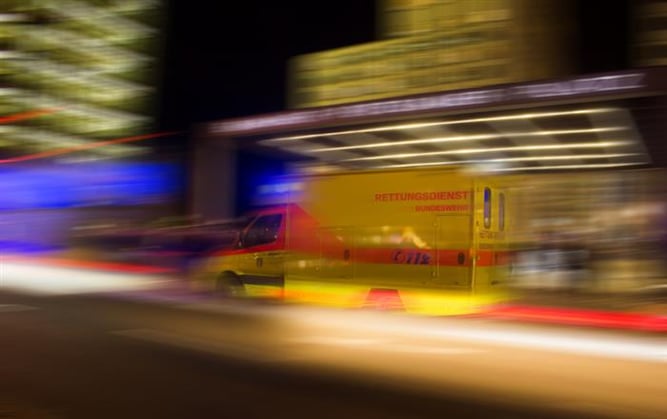 The call comes in as a “gunshot wound to the head,” and you arrive on scene to find a middle-aged male with what appears to be a self-inflicted, small caliber entry wound to the right temple. He is sitting in a recliner and bleeding profusely from the nose and mouth. You carefully place him on a backboard, but once he is supine, his airway quickly fills with blood. Things are not looking good.
The call comes in as a “gunshot wound to the head,” and you arrive on scene to find a middle-aged male with what appears to be a self-inflicted, small caliber entry wound to the right temple. He is sitting in a recliner and bleeding profusely from the nose and mouth. You carefully place him on a backboard, but once he is supine, his airway quickly fills with blood. Things are not looking good.
This patient obviously needs a secure airway. There’s only so much you can do for the gunshot wound in the field, but you can certainly correct the airway obstruction. I hope you brought your portable suction unit with you.
This patient will obviously be difficult to intubate. Airway management is always compounded when bleeding is profuse. But airway management in any patient can be tenuous when treating patients in the field. Hospital personnel have little appreciation for the rigors of field treatment. The sterile, well-lit setting of a hospital ER can hardly compare to the complex situations in which paramedics must function, which include:
- The tight confines of a crushed automobile
- The dark and dirty surroundings of a city street
- Cramped and poorly lit apartments
These are just a few of the situations in which paramedics must work, which can make any type of treatment difficult, especially intubation. But aside from the challenging settings of EMS, the success or failure of intubating the critical patient comes down to two things: the skill of the paramedic and the right equipment to do the job.
Success and the Role of the Paramedic
Intubation failure rates among paramedics have been under close scrutiny for many years, especially as new equipment and treatment strategies emerge. The use of alternative airway adjuncts and the rise of RSI among emergency responders have focused attention on the effectiveness and appropriateness of endotracheal intubation. And most studies have found that improved education and training are critical to elevating the success rates of ETI among paramedics. Intubating live patients in the OR under the direction of a physician and upping the number of required supervised intubations in the field are two main ways of improving the skills of new paramedics, while continuing education and training can keep those skills fresh as one moves through their career. And although training is key to keeping failure rates in the field down, there is also a simple way of improving your odds when it comes to successfully intubating your patient: have the right tools for the job.
Improving Your Success Rates: Equipment, Equipment…
Let’s face it, you can’t perform standard endotracheal intubation if you can’t see the cords. And in the presence of blood or vomit, there’s no way to visualize the cords if you’ve left your suction unit on the truck. Preplanning is one of your main responsibilities as a paramedic and when it comes to ETI, you should always suspect your patient has a full belly and that vomiting is inevitable. That way, you’re prepared for the worst.
But vomit is not your sole concern. Let’s return to our gunshot wound…
You’ve initiated CPR and you are setting up your intubation equipment. Although you’ve got the patient on a board, the tight confines of the living room make positioning difficult. A dog is barking in the next room, the radio chatter is intense, and the only light available is the single dim bulb dangling from the ceiling. And aside from all of this, your patient’s mouth is continually filling with blood.
Fortunately, you’ve planned ahead. There’s nothing you can do about the small apartment, but your lieutenant brought his spotlight and he’s providing the light you need. As your partner readies the tube, you grab your portable suction unit and get to work on that airway. Thankfully, you have an efficient unit with the appropriate and your battery is charged and ready to go. You crank on the suction, quickly clear the airway, and begin to ventilate your patient as CPR continues. As your partner prepares to intubate, you synchronize your suctioning to provide a clear view of the cords as he slips the tube in. Once the tube is secured and the patient is being ventilated, you continue to suction as your patient is packaged for transport.
and your battery is charged and ready to go. You crank on the suction, quickly clear the airway, and begin to ventilate your patient as CPR continues. As your partner prepares to intubate, you synchronize your suctioning to provide a clear view of the cords as he slips the tube in. Once the tube is secured and the patient is being ventilated, you continue to suction as your patient is packaged for transport.
All calls should go this smoothly. Unfortunately, EMS is fraught with difficulty when it comes to patient treatment, especially in the critical case of airway management. The dangerous, complicated settings inherent to emergency scenes are just part of the challenge when it comes to endotracheal intubation. Lack of education and training, and rusty skills are the prime reason behind failed intubations, so take aggressive measures to improve your technique. Continuing education and practicing in the lab can vastly improve your success rates. And once you’re proficient, be sure to always carry the right equipment with you at all times. You never know when you’ll need it.
2016, Moy, HP and A Andino. Evidence-Based Medicine: Endotracheal Intubation, EMS World, http://www.emsworld.com/article/12024237/the-evidence-behind-prehospital-endotracheal-intubation.














